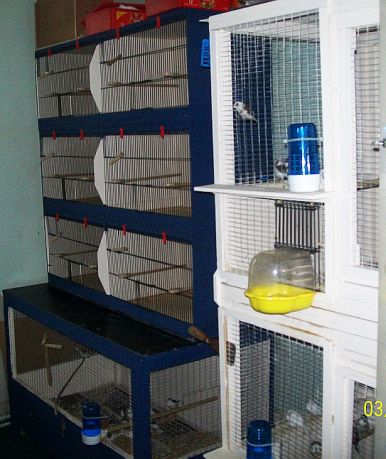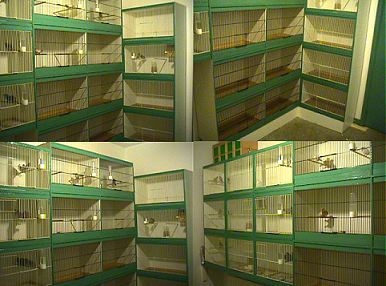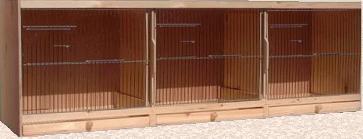





When I look back on my early days of
bird-keeping in the late 1950's I recall I seemed to gain as much pleasure
from obtaining the materials and building my cages and flights as I did from
the other aspects of my bird keeping.Where I lived in those early days, and
still do, in South East London a huge re-development of housing was
underway, the many streets of little terraced houses were being
demolished to make way for tower blocks, that themselves are now going due
to bad architectural and social design.
I lived in one of those streets of terraced
houses, fortunately one that at the time did not fall under the planners
eye, although now it is long gone and even the street name has disappeared.
Much of my free time was spent in searching those empty house awaiting
demolition for any materials I could re-cycle into housing for my birds, old
wardrobes, cabinets etc. were broken down and transported home on my cart, I
found a surprising amount of chicken wire in the deserted gardens and on one
occasion a nearly new garden shed that took ages to break down and
transport, but it housed my birds for many years. Anything that looked
useable from wooden boxes from the grocers to packing cases from a nearby
sign factory were put to use, money was more than tight in those days, my
Father died when I was eight, I was the oldest of 4 children my Mother had
several jobs that took her away from home for 12 hours a day, just so
we could eat and keep a roof over our heads, so anything beyond that was
impossible without a lot of making do with what you could find or earn for
yourself.
I was working for a pet shop/bird importer,
cleaning cages, feeding animals and birds each evening and the weekends, I
rarely came home with any money, it seemed every pay day there was some bird
I wanted or seed I needed, Budgerigars gave me a lot of independence in my
early days, they were a tremendously popular pet, and as soon as a nest was
weaned they were sold, Budgies financed my bird-keeping for a good few years
in the late 50's early 60's, Dreaming of pots of money my thoughts turned to
the Gouldian Finch and this is the time I obtained my first Bengalese, all I
can say is I bred a lot of Bengalese but never had a pocket full of money
from my Gouldian endeavours.
Wandered a bit off course there, so back to the
reason for this page housing your birds.
It will of course be down to individual
circumstances were you choose to house your birds, it may be in a shed in
the garden, spare room or custom built bird room, but wherever it is you
need to ensure you have control over temperature, humidity and lighting,
This means you can ensure it isn't too hot, cold or damp and you can provide
adequate lighting, all this is down to thought in your design and there are
many books and articles in the fancy press that can greatly assist you in
this aspect.But in essence Bengalese are mainly kept in cages if you are
interested in breeding with some idea of the parentage of your offspring,
here in the UK box type cages as illustrated above are almost universally
used, but on my trips to other fanciers bird rooms I have seen all wire
cages used especially in the USA and they are fine, most fanciers build or
buy the box cages that can be by the use of wooden slides be divided into
individual breeding cages at the start of breeding and then used as longer
flight cages outside of the breeding season, the usual size for an
individual breeding cage is 24ins in length, 15ins in height and 12 ins
deep, I'm a stick in the mud and use imperial, metric is not for me, I
recommend the above as a minimum size for breeding seen much smaller cages
being used, avoid it and make them as big as you can.
Consider your cage furniture ensure you can
easily clean your cages a wooden slide out tray is ideal, your food and
water vessels need to be easy to clean, I recommend outside the cage
tubular water fountains, and any dishes be round, easier to keep clean, no
corners where dirt can be difficult to clean from. One of the most important
pieces is a bath, those that hang on the cage door are ideal,
Bengalese are avid bathers and a daily bath can
only benefit them both in health and condition.
Cages for Bengalese are readily available on the
internet from many manufactures although for the average handy person they
are easy enough toconstruct, give a lot of consideration to your housing,
mistakes can be costly to put right.
Jim Warburton

